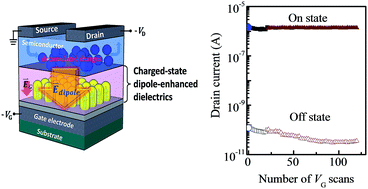Highly energy-efficient and air-stable organic transistors by an ultrathin hybrid dielectric with large internal voltage generation†
Abstract
This study presents an approach to design hybrid dielectrics with ultrahigh capacitance density at extremely low supply voltages that behave like supercapacitors and are thus energy efficient. Hybrid dielectrics are fabricated from polymer/metal-oxide bilayer films with real-time and effective internal voltage generated by chemically interlocking interfacial species at the charged state. The designed dielectrics are named charged-state dipole-enhanced (CSDE) dielectrics. We demonstrate their potential use in ultralow voltage driving organic field-effect transistors (FETs) characterized by the high performance and great stability. Using the CSDE dielectrics, organic FETs with a pentacene active layer can deliver adequate performance and excellent operational stability at ultralow operating voltage in air. The linear field-effect mobility of pentacene-based FETs can be as high as 1.5 cm2 V−1 s−1 at only 0.1 V. After long-term storage and continuous operation in air, the FETs still exhibited outstanding electrical performance. Several advantageous features of the designed CSDE dielectrics are presented, thereby providing a glimpse into the future of energy-efficient electronics.


 Please wait while we load your content...
Please wait while we load your content...